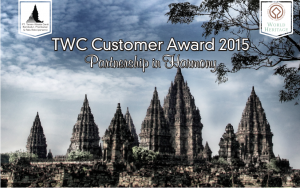Gold Paper Found in Ratu Boko

There are various discoveries of archaeological objects in the plains of Ratu Boko. The heritage objects could have been the attributes of the kingdom that existed in the area in the past or the instruments of religious teachings performed there. Whatever the form, these relics are a way that can be used to read the Keraton Ratu Boko in the past.
One of the important archaeological discoveries of the Ratu Boko plain was a piece of gold paper that was discovered in the 1940s (did not know when the exact date, this data was recorded in 1950). It looks like this paper has long gone, but the picture still survives. The shape resembles a diamond by Sundberg (2003) interpreted as a vajra (in Sanskrit means lightning or diamond), a symbol of Indra in Hinduism, and in Buddhism the characteristics of the Buddhist God known as Vajrapani.
The paper contains 4 copies of each spell on each side of the diamond. The mantra has similarities with other Buddhist spells found in several places in Yogyakarta such as Abang Temple. In addition, the gold paper is also written with words Panarabwan and Khanipas.
The writing contained in the gold paper probably dates from around the year 783 to 803 which can be said as the beginning of the construction of monuments on the plains. The writing which reads Panarbwan may be another name of Raka originating from the Panarban mentioned in the Wanua Tengah inscription from 908 that was appointed the king in 784. The gold paper may have been stored near the gate at the same time as the construction of the monastery in the pendopo of Ratu Boko performed by the same king, Panarabwan. He may be the same person mentioned in another inscription under the name Samaratungga. The name change took place after he followed the Buddha’s teachings.
Sundberg concludes that the mantra in Ratu Boko comes from a yoga tantra illustrating how Trilokavijaya forced Siva to recognize the Buddha superior to him after he was put into a mandala by the Vajrapani Buddha. This may give us an explanation of the relationship between some of the court members present in Java at the time, and a hostility among those who followed Buddhism and those who followed Hinduism.
Through the discovery of this gold paper, an attempt can be made to read Ratu Boko’s religious and political life in the past. In the same way, Ratu Boko’s past that is still unknown, little by little, can be understood further.
#indonesia #indonesiatourism #borobudur #prambanan #ratuboko
#wonderfulindonesia #temple #unesco #buddhis #java


